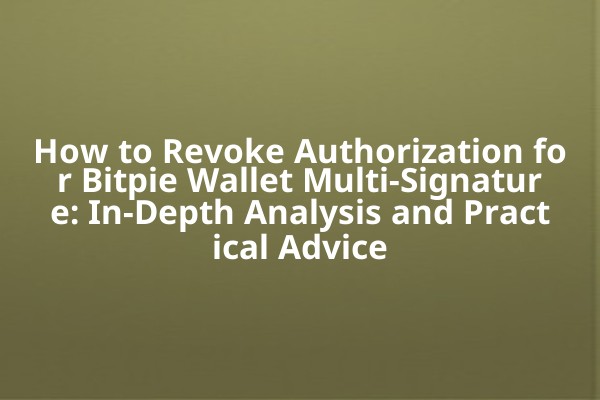




In today's era of increasing digital currency adoption, Bitpie Wallet has become a favored digital asset management tool for a growing number of users due to its convenience. The wallet's multi-signature feature not only provides enhanced security but also increases users' flexibility in asset management. However, when using the multi-signature function, users may encounter the need to revoke authorizations. This article will explore in detail the process of revoking multi-signature authorizations in Bitpie Wallet, including security considerations, common issues, and methods to improve management efficiency.
Multisignature (Multisignature) is a cryptographic technology that requires multiple key holders to jointly sign in order to carry out specific transactions. For Bitpie Wallet, the multisignature feature allows users to require authorization from multiple designated keys when making large transactions, thereby protecting asset security. For example, if three signatures are set and at least two are required to complete a transaction, even if one key is stolen, an attacker still cannot easily transfer the funds.

Multisignature has a wide range of use cases, the most common of which include:
There are various reasons why users may need to revoke multisig authorization, mainly including:
Revoking unnecessary or no longer secure multi-signature authorizations can help users further reduce risk and ensure that assets remain under control. Unauthorized transactions can be avoided, safeguarding the security and controllability of funds.
Before performing the de-authorization operation, the user should:
First, launch the Bitpie Wallet app and make sure you are connected to a trusted network to avoid performing sensitive operations on public networks.
On the Bitpie wallet homepage, find the "Settings" option and enter the "Multisig Wallet" or "Multisig Management" interface. In this interface, you can view the existing multisig settings information.
In the multi-signature wallet management interface, the user needs to locate the signer to be revoked and click the corresponding "Revoke Authorization" button. At this point, the system may require confirmation information to ensure that the operation is being performed by the user themselves.
After entering the confirmation information, the system will re-verify the user's identity and prompt the user about the consequences of the revocation operation. The user must read carefully to confirm whether to proceed with this operation. Once finally confirmed, the revocation will be recorded.
After the operation is completed, the user needs to review the multisig settings after revocation to ensure the information has been updated, and be sure to securely save the new authorization information.
During the deauthorization process, users should take a series of security protection measures:
Users should regularly back up relevant data of the multi-signature wallet to prepare for unexpected situations. Backup information can be stored on encrypted devices or in secure cloud storage.
After revoking authorization, the original authorization record will be deleted and cannot be recovered. If the user needs to grant authorization to a signer again, it will need to be set up anew.
The undo operation is generally quick and usually completed within a few minutes. The specific time depends on the network status and transaction confirmation.
The Bitpie wallet system will take security measures to prevent malicious operations. When users confirm an action, it cannot be executed unless the correct information is entered.
Transactions that have already been initiated and are in progress will not be affected. Revoking the multi-signature will only impact future transactions.
If the authorizer is unable to access their key, it usually requires joint decision-making by other signers to make changes, or contacting the Bitpie Wallet support team for assistance.
It is recommended that users regularly review the settings of their multi-signature wallets to ensure that the key holders match actual requirements, and make timely changes to safeguard account security.
Auxiliary management tools can be used to help record and track the usage and change history of multi-signature wallets, preventing omissions.
For teams and enterprise users, regular training sessions should be held to enhance members' understanding of multisignature setup and operational skills, thereby reducing asset risks caused by improper operations.
When managing a multi-signature wallet, ensure compliance with local laws and regulations, and handle all funds and transaction activities in a legal and compliant manner.
In multi-signature management, the responsibilities and authorities of each signer should be clearly defined, and good communication should be maintained during the authorization and revocation processes to ensure scientific and rational signature management.
Through the above analysis and guidance, users have gained a deeper understanding of the multisig revocation operation in Bitpie Wallet. It is hoped that this information will be helpful to everyone and encourage more effective management of digital assets, ensuring both security and flexibility. In this digital age, better protection of asset security lays a solid foundation for future investments.